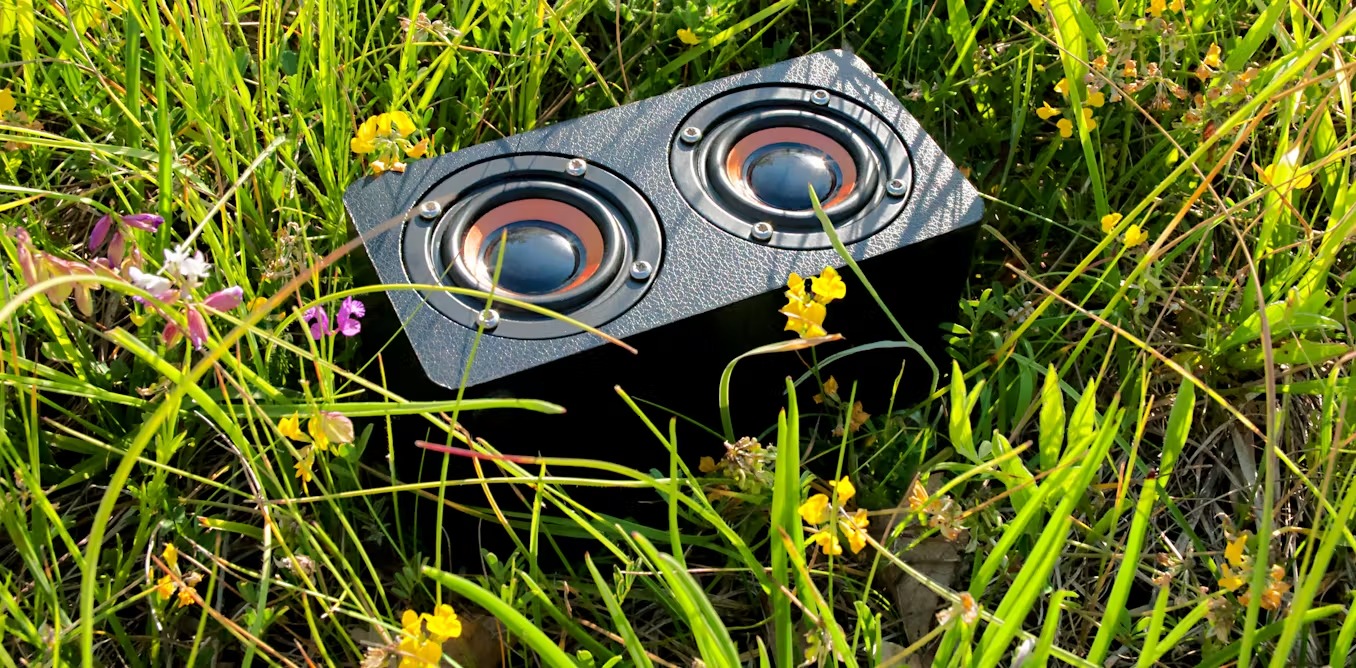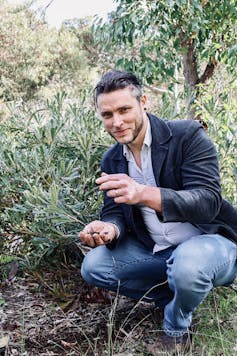In a race against time, scientists are exploring new ways to restore natural systems. Alongside traditional methods such as planting trees, reducing pollution and reintroducing native species, a surprising new tool is emerging: sound. Ecologists can harness sound to bring life back to degraded ecosystems.
On land and at sea, natural soundscapes are being replicated to stimulate growth, reproduction and even communication among species. Sound is already being used to restore oyster beds and coral reefs.
In our new research, we found beneficial plant microbes are also receptive to sound. We used high-frequency white noise to stimulate a fungus that promotes plant growth. The noise is a bit like the sound emitted in between channels of an old-fashioned radio.
This adds a new dimension to restoration projects. Imagine using tailored soundscapes to restore wetlands, forests or grasslands, simply by artificially amplifying the sonic cues that attract wildlife, stimulate growth and rebuild relationships between species. We see a bright future for this “biodiversity jukebox”, with tracks for every ecosystem.
Sound as an ecological tool
In healthy ecosystems, everything from animal calls to water trickling underground creates a sonic landscape or “soundscape” that ultimately supports biodiversity.
Conversely, the soundscapes in degraded ecosystems are often diminished or altered. This can change the way species behave and ecosystems function.
Marine biologists were among the first to explore sound as a tool for restoring Australia’s southern oyster reefs. Intact oyster reefs provide habitat for many species and prevent shoreline erosion. But pollution, overharvesting and dredging almost wiped them out more than a century ago.
It turns out playing sounds of healthy reefs, namely snapping shrimp, underwater encourages baby oysters to settle and grow. These sounds mimic the natural environment of thriving oyster beds.
The results have been impressive. Oyster populations show signs of recovery in areas where soundscapes have been artificially restored.
Similarly, fish support healthy coral reefs by grazing on algae that can otherwise smother corals. Playing the sounds of healthy coral reefs can attract young fish to degraded reefs. This helps kickstart reef recovery.
Oyster reef restorations offer cleaner water and the return of once-thriving ecosystems.
— The Conversation - Australia + New Zealand (@ConversationEDU) October 30, 2022
To draw oysters back to the barrens where their reefs once stood, it helps to play them a little underwater background music, as @UniofAdelaide researchers found. https://t.co/6M3f4RSHdK
The power of sound in plant microbiology
Building on these successes, we ventured into new territory. In our new research we used sound to stimulate the growth of soil microbes.
These microbes play an essential role in plant health. Some promote nutrient uptake in plants, others protect against disease. But these communities of microorganisms can be diminished and disrupted in degraded soils, hampering plant growth and ecosystem recovery.
We wanted to find out whether specific sounds could encourage the growth of these beneficial microbes. We ran a series of experiments, to test the effect of sound on the growth and reproduction rate of a particular fungus known to stimulate plant growth and protect against diseases.
We grew the fungus in the laboratory in 40 Petri dishes and subjected half of them to treatment with sound. We played a sound recording similar to the high-frequency buzz of white noise for 30 minutes a day over five days. Then we compared the amount of fungal growth and the number of spores between the two groups.
In technical terms, the frequency was 8 kHz and level was 80 dB, which is quite loud, like the sound of a busy city street or vacuum cleaner, almost loud enough to damage hearing.
We used a monotonous sound for experimental reasons, because it is easy to control. But a more natural or diverse soundscape may be even better. We plan to do more research on this in the near future.
We found sound stimulated the fungi, increasing the growth rate by more than seven times and the production of spores by more than four times compared to the control (no sound).
Acoustic tech allows us to listen to the sounds produced by the creatures in forest soils.
— The Conversation - Australia + New Zealand (@ConversationEDU) May 27, 2023
A new study by @_jake_robinson, Carlos Abrahams + @_MBreed shows it’s a reliable way to monitor biodiversity and health of the soil and forest. @TrentUni @Flindershttps://t.co/eddhS0CAD0
Why sound works
Why does sound have such a powerful effect on ecosystems? The answer lies in the way organisms interact with their environment.
Sound travels almost five times faster in water than in air, making it an efficient means of communication for marine life such as oysters, fish and whales.
Trees detect the soundwaves produced by running water, and their roots move towards the vibration.
We already know sound influences the activity of microbes. We think it stimulates special receptors on the membranes of the microbes. These receptors might trigger a response in the cells, such as switching genes responsible for growth on or off.
By listening to the “heartbeat” or soundscape of soil, we can learn more about its condition. Think of poor soil as a lifeless party. Healthy soil is where you’ll find the good vibes and chatter. @flinders https://t.co/Fnl9ErVijz
— The Conversation - Australia + New Zealand (@ConversationEDU) August 16, 2024
Is sound the future of restoration?
Microbes support plant life, help maintain soil structure, hold water and store carbon. By stimulating beneficial microbes with sound, we may be able to improve large-scale restoration projects. This approach may also support regenerative agriculture, where farming works with nature rather than against it.
The author, Jake Robinson, in the field. Flinders University
Our next steps include refining the sound patterns that are most effective in different ecosystems. We then need to scale up our research to test different sounds in diverse environments. We envisage creating a “biodiversity jukebox” of beneficial sounds to enhance ecosystem health.
It’s clear what we hear – and don’t hear – profoundly influences the environment. So we’re also interested in noise cancellation. By this, we mean barriers to protect ecosystems from potentially undesirable noises. For instance, we’re asking questions such as: do traffic and industrial noises harm the ecosystem?
As ecosystems face increasing pressure from climate change, biodiversity loss and habitat destruction, sound can become a powerful tool for restoration.
While the science is still in its infancy, it has huge potential.
Ultimately, sound-based restoration might offer a low-impact and cost-effective approach to help ecosystems recover. The future of restoration could be as much about what we hear as what we see.



 5 elections to watch in 2025
5 elections to watch in 2025  Like your pet more than people? So did some of the Greco-Romans
Like your pet more than people? So did some of the Greco-Romans  What does 2025 hold for interest rates, inflation and the American consumer?
What does 2025 hold for interest rates, inflation and the American consumer?  The secret world of plants living in our limestone pavements
The secret world of plants living in our limestone pavements  We don’t all need regular skin cancer screening – but you can know your risk and check yourself
We don’t all need regular skin cancer screening – but you can know your risk and check yourself  Dogs and cats get diabetes too. Here’s what to look out for and how to manage it
Dogs and cats get diabetes too. Here’s what to look out for and how to manage it  Sport produces mountains of high-tech waste. We are finding new ways to recycle it
Sport produces mountains of high-tech waste. We are finding new ways to recycle it  How a new map of the UK’s blue carbon habitats could change how oceans are protected
How a new map of the UK’s blue carbon habitats could change how oceans are protected  Sonic Labs' Bold Leap: Fantom's Transformation into a Scalable Blockchain Giant
Sonic Labs' Bold Leap: Fantom's Transformation into a Scalable Blockchain Giant  Hurricane Milton explodes into a powerful Category 5 storm as it heads for Florida − here’s how rapid intensification works
Hurricane Milton explodes into a powerful Category 5 storm as it heads for Florida − here’s how rapid intensification works 


































